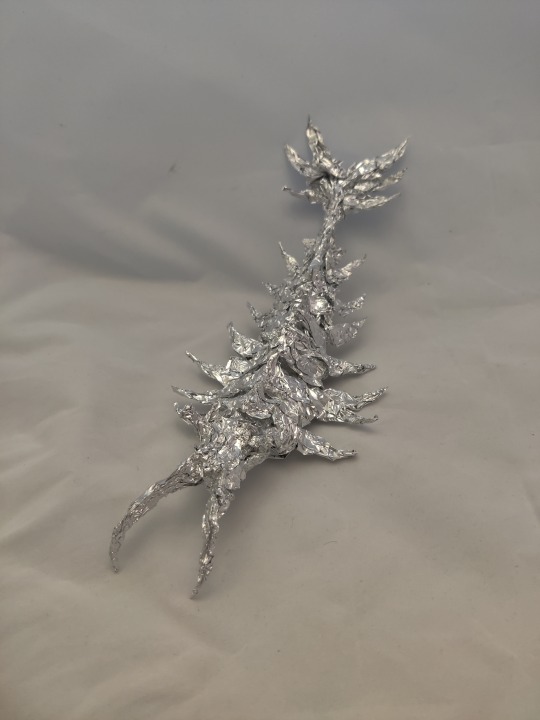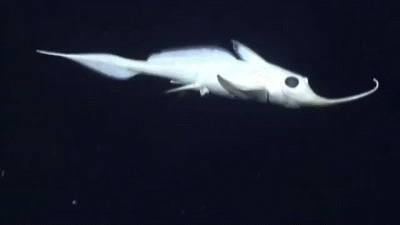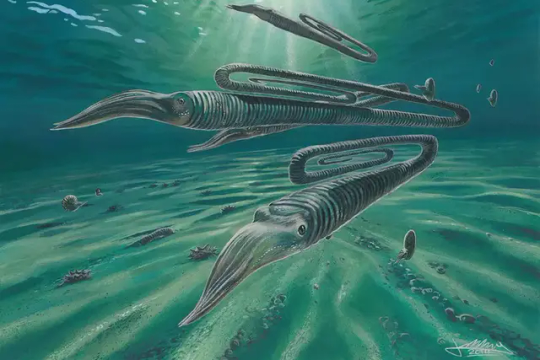#fossil sea creature
Explore tagged Tumblr posts
Photo

VERY RARE: Spiroceras bifurcati Fossil Heteromorph Ammonite – Inferior Oolite, Jurassic Coast, Burton Bradstock, Dorset, UK
Offering a highly rare and visually striking Spiroceras bifurcati heteromorph ammonite fossil from the Jurassic Coast, Burton Bradstock, Dorset, UK. This unique fossil specimen was excavated from the famous Inferior Oolite Formation, a classic Jurassic unit renowned for preserving a wide array of ammonite species in beautiful condition.
Geological Unit: Inferior Oolite Formation
Geological Period: Jurassic
Stage: Bajocian (Middle Jurassic)
Depositional Environment: Shallow marine carbonate platform
Order: Ammonitida
Superfamily: Stephanoceratoidea
Family: Hammatoceratidae
The Spiroceras bifurcati is a heteromorph ammonite known for its coiled and irregular shell morphology—a rarity among ammonites. The spiral and bifurcated whorls make it highly desirable for collectors and palaeontologists alike.
This rare specimen was collected on 30 April 2025 by our skilled fossil hunters, Alister and Alison. It has been expertly cleaned and conserved by Alison, maintaining the specimen’s authenticity and scientific integrity. The fossil remains embedded in its original limestone matrix.
The images show the actual fossil you will receive. A 1cm scale cube is shown for reference—please see all listing photos for full sizing details.
All of our Fossils are 100% Genuine Specimens & come with a Certificate of Authenticity.
A once-in-a-lifetime chance to own a rare Spiroceras bifurcati ammonite—perfect for discerning collectors, natural history enthusiasts, or as an educational centrepiece.
#Spiroceras bifurcati#heteromorph ammonite#rare ammonite fossil#Jurassic fossil ammonite#Dorset fossil ammonite#Inferior Oolite ammonite#ammonite with certificate#Jurassic Coast fossil#unusual ammonite fossil#ammonite gift for collectors#fossil sea creature
0 notes
Text



Potamon sp. Crab Fossil; Pleistocene Epoch (2.58 - 0.012 MYA)
#fossil#fossils#crab fossil#prehistoric#collectible fossil#fossil collection#sea fossil#marine biology#marine fossil#special collections#collectibles#crystals#geology#rocks and minerals#stone aesthetic#paleontology#naturalhistory#evolutionarybiology#natural#natural history#natural life#marine animals#gemstones#sea creatures#sea life#marine life#sea animals
17K notes
·
View notes
Text

Living Fossils - Creatures that remain seemingly unchanged by time. Here's the Coelacanth, the Sturgeon, the Gar, the Horseshoe Crab and the Nautilus! (Gouache on 50x40cm canvas, SOLD)
#living fossils#marine biology#sea life#fish#coelacanth#sturgeon#gar#horseshoe crab#nautilus#sea creatures#marine life#gouache#traditional art#my art
12K notes
·
View notes
Text

It’s Fossil Friday! Let’s swim back in time about 85 million years to the Late Cretaceous to meet Xiphactinus, a gigantic predatory fish. This species could reach lengths of 17 ft (5.2 m) and was capable of swallowing a 6-ft- (2-m-) long fish whole! The Museum’s Xiphactinus fossils come from Logan County, Kansas, which is home to 70-ft- (21.3-m-) tall sedimentary formations. Though that might not sound like an ideal home for an ocean-dweller, the entire area was covered by a vast inland sea during the Cretaceous. See Xiphactinus in the Museum’s Hall of Vertebrate Origins!
Photo: Image no. ptc-6634 © AMNH (taken 1996)
#science#amnh#museum#fossil#nature#natural history#animals#fact of the day#did you know#fish#paleontology#late cretaceous#cretaceous#sea creatures#marine biology#marine animals#natural history museum#american museum of natural history
1K notes
·
View notes
Text

Anomalocaris - Aluminum Foil Sculpture
#anomalocaris#anomalocaris art#prehistoric#cambrian#fossil#sea creature#sea life#foil#sculpture#fanart
3K notes
·
View notes
Text
Coelacanths are so cool, I wish they were rea- wait a minute
#imagine being a coelacanth enjoyer in 1938 and finding out that your favourite prehistoric fish is still alive and kicking#i would've gone crazy#coelacanth#coelacanths my beloved#coelacanth memes#prehistory#prehistoric#prehistoric sea creatures#living fossil#living fossils#memes#the insomniac archives
738 notes
·
View notes
Text

a bunch of very weird Cambrian period creatures
I have a sticker of this print up on my Etsy if anyone is interested
terfs fuck off
made in 2023
#cambrian#cambrian period#prehistory#prehistoric animals#prehistoric art#sea creatures#sea creature art#fossils#animal art#ocean animals#artists on tumblr#block print#block printing#printmaker#printmaking#traditional art#traditional printing#traditional printmaking#linoprint#linogravure#linocarving#linocut print#linocut#small artist#original art#butch artist#lesbian artist#trans artist#nature art#disabled artist
370 notes
·
View notes
Text
Longnose Chimaera

Longnose Chimaera (Harriotta raleighana)
This deep-sea oddity belongs to the Chimaeridae family and is found in temperate and tropical deep waters, often at depths of 1,600 to 8,500 feet.
Sometimes called a "ghost shark," this ancient fish is more closely related to sharks and rays than true bony fish!
Its elongated snout is covered in sensory pores, helping it detect prey in the darkness of the deep sea.
#eocene period#fossil fish#fossil tooth#fossilized tooth#marinette dupain cheng#prehistoric#marine life#marine biology#space marines#marine animal#fish#sal fisher#fish.txt#sea creatures#octopus#banana fish#aquatic life#fishes#fishblr#aquatic
45 notes
·
View notes
Text
Daily Ray Fact:
The Fiddler Ray and their relatives are thought to be the oldest ray group, which explains why they are somewhere between a shark and a ray. It is understood that rays evolved from sharks and so really the Fiddler Ray is a visual demonstration of that change in biology, The earliest known fossil rays are only 150 million years ago and whilst there are very few well preserved fossils available there are whole bodies of ancient guitarfishes which very closely resemble that of modern day Fiddler Rays.


#fiddler ray#ancient ray#dinosaur?#fossil relative#daily stingray#stingrays#stingray facts#ray facts#daily ray facts#daily stingray facts#ray family#respect the locals#cartilaginous fish#ocean#ocean life#marine life#sea creature#animals
291 notes
·
View notes
Text

Convergent evolution is the evolution of 'analogous' or similar structures in organisms that are not closely related. Such as the wings of insects, birds and bats. One potential example of this is the Diplomoceras maximum, an extinct squid-like creature who is clearly analogous to, or a distant cousin of Clippy the paperclip. This amazing creature lived 68 million years ago, with the most notable fossil found at the cephalopod rich López de Bertodano Formation of Seymour Island, Antarctica. An area that was formerly warmer before further movement of tectonic plates. The fossil shell measured an impressive 1.5 metres and is formed from ridges, speculated to grow a section annually. These ribs are thought be similar to tree rings, being used for dating samples and gaining insight about the environment of the prehistoric sea, such as measuring the carbon and oxygen isotopes in the shell. Paleoart by James McKay
#marine biology#marine life#marine animals#ocean animals#marine zoology#cephalopods#molluscs#paleontology#fossils#ocean#wet beast wednesday#marine ecosystem#marine#zoology#animal facts#animalia#animal#sea animals#sea creature#sea creatures#sea life#ocean life
205 notes
·
View notes
Text

#trilobite#trilobites#diagram#science#biology#archaeology#fossil#taxonomy#creature#exoskeleton#sea creature
35 notes
·
View notes
Photo

VERY RARE: Spiroceras bifurcati Fossil Heteromorph Ammonite – Inferior Oolite, Jurassic Coast, Burton Bradstock, Dorset, UK
Offering a highly rare and visually striking Spiroceras bifurcati heteromorph ammonite fossil from the Jurassic Coast, Burton Bradstock, Dorset, UK. This unique fossil specimen was excavated from the famous Inferior Oolite Formation, a classic Jurassic unit renowned for preserving a wide array of ammonite species in beautiful condition.
Geological Unit: Inferior Oolite Formation
Geological Period: Jurassic
Stage: Bajocian (Middle Jurassic)
Depositional Environment: Shallow marine carbonate platform
Order: Ammonitida
Superfamily: Stephanoceratoidea
Family: Hammatoceratidae
The Spiroceras bifurcati is a heteromorph ammonite known for its coiled and irregular shell morphology—a rarity among ammonites. The spiral and bifurcated whorls make it highly desirable for collectors and palaeontologists alike.
This rare specimen was collected on 30 April 2025 by our skilled fossil hunters, Alister and Alison. It has been expertly cleaned and conserved by Alison, maintaining the specimen’s authenticity and scientific integrity. The fossil remains embedded in its original limestone matrix.
The images show the actual fossil you will receive. A 1cm scale cube is shown for reference—please see all listing photos for full sizing details.
All of our Fossils are 100% Genuine Specimens & come with a Certificate of Authenticity.
A once-in-a-lifetime chance to own a rare Spiroceras bifurcati ammonite—perfect for discerning collectors, natural history enthusiasts, or as an educational centrepiece.
#Spiroceras bifurcati#heteromorph ammonite#rare ammonite fossil#Jurassic fossil ammonite#Dorset fossil ammonite#Inferior Oolite ammonite#ammonite with certificate#Jurassic Coast fossil#unusual ammonite fossil#ammonite gift for collectors#fossil sea creature
0 notes
Text

Pleistocene Epoch Fossilized Crab


Potamon sp. Crab Fossil; Pleistocene Epoch (2.58 - 0.012 MYA)
#crab fossil#marine biology#marine fossil#sea fossil#stone aesthetic#special collections#collectibles#fossils#fossil#paleontology#pleistocene#geology#rocks and minerals#prehistoric#Pleistocene Fossil#fossilized crab#earth#marine animal#evolutionarybiology#sea creatures#natural history#eartharchives#naturalhistory#fossil collection
133 notes
·
View notes
Text

✨Beautiful Ammonite fossils with a lovely array of rainbows! Shop here✨🖤
#pumpkin#fall#ammonite#fossil#rainbow#flash#flashy#crystal#rainbow crystals#minerals#fossils#geology#crystals#nature#goodvibes#healing#earth#metaphysical#pagan#fairy#rainbow aesthetic#crystal aesthetic#altar#witchy#halloween#samhain#fall aesthetic#sea creature#ocean#ocean core
49 notes
·
View notes
Text

A couple posts before this, I showed people a couple feather star's. As mentioned, they're a species of Crinoids. I mentioned how their species subset dates back to millenniums; but to showcase it, here's an example of a plant-based crinoid. Both the plant-based crinoids that were rooted into sand and crinoids like feather stars that evolved to swim amongst fish are both part of animalia, but one behaves like a plant and the other behaves like a mobile fish; each thriving in the same if not similar way, just more efficiently depending.
────────────────────────────────────────────
⇾ Follow my page for more epic, silly and boomblu content; share so I can grow if you wish, and come visit my other socials at my Linktree [Just click the word Linktree, it's hyperlinked :)]. ⇽
Check out the rest of my posts too!!! A lot of them are underrated. ;o Like everything you find interesting if you want. :3 Remember, you can find all of my socials here (click the word [here], it's hyperlinked (。◕‿‿◕。) For the plain link; here it is: https://lynkfire.com/Gliphel&Glyph%20LLC%20Incorperated Also; if you prefer Linktree, it's here.
#fossil#fossils#paleontology#evolution#prehistoric#prehistoric life#dinosaur#palaeoblr#marine life#marine#marine biology#aquatic#sea creatures#aquatic life#sea animals#sea life#sea#ocean#water
228 notes
·
View notes
Text

What is that in the distance? an island? land finally….but that island moves!? It is the Shonisaurus, with its colossal size it crushed everything in its path. Traces of prehistoric times seem to be engraved on their skin.
#digital art#digitalart#digital#digital drawing#dinosaurs#dinosaur#dinosaur rpg#rpg#rpg creature#sea creature#prehistoric#prehistoric creature#rock#rock type#shonisaurus#reptile#sea reptile#fossil#conceptart#concept art
39 notes
·
View notes